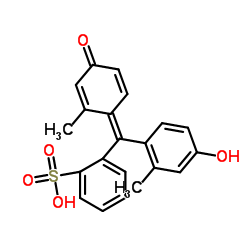3-cresol purple

3-cresol purple structure
|
Common Name | 3-cresol purple | ||
|---|---|---|---|---|
| CAS Number | 2303-01-7 | Molecular Weight | 382.430 | |
| Density | 1.4±0.1 g/cm3 | Boiling Point | 577.5ºC at 760 mmHg | |
| Molecular Formula | C21H18O5S | Melting Point | >250°C | |
| MSDS | Chinese USA | Flash Point | N/A | |
|
Morphological plasticity of the coral skeleton under CO2-driven seawater acidification.
Nat. Commun. 6 , 7368, (2015) Ocean acidification causes corals to calcify at reduced rates, but current understanding of the underlying processes is limited. Here, we conduct a mechanistic study into how seawater acidification alters skeletal growth of the coral Stylophora pistillata. Re... |
|
|
Spectrophotometric calibration of pH electrodes in seawater using purified m-cresol purple.
Environ. Sci. Technol. 46(9) , 5018-24, (2012) This work examines the use of purified meta-cresol purple (mCP) for direct spectrophotometric calibration of glass pH electrodes in seawater. The procedures used in this investigation allow for simple, inexpensive electrode calibrations over salinities of 20-... |
|
|
Apical extrusion of sodium hypochlorite using different root canal irrigation systems.
J. Endod. 37(12) , 1677-81, (2011) Root canal irrigation carries a risk of extrusion of irrigant into the periapical tissues. The objective of this study was to compare different irrigation systems in matched pairs of teeth prepared to an apical size of 35.06 and 50.06 by measuring the frequen... |
|
|
A lifetime-based optical CO2 gas sensor with blue or red excitation and stokes or anti-stokes detection.
Anal. Biochem. 227(2) , 309-18, (1995) We describe the fabrication and characterization of an optical CO2 sensor based on the change in fluorescence lifetimes due to fluorescence resonance energy transfer from a pH-insensitive donor, sulforhodamine 101, to a pH-sensitive acceptor, either m-cresol ... |
|
|
Haloalkane dehalogenases: steady-state kinetics and halide inhibition.
Biochemistry 38(18) , 5772-8, (1999) The substrate specificities and product inhibition patterns of haloalkane dehalogenases from Xanthobacter autotrophicus GJ10 (XaDHL) and Rhodococcus rhodochrous (RrDHL) have been compared using a pH-indicator dye assay. In contrast to XaDHL, RrDHL is efficien... |
|
|
Simple, rapid spectrophotometry of urinary N-acetyl-beta-D-glucosaminidase, with use of a new chromogenic substrate.
Clin. Chem. 29(10) , 1713-6, (1983) We have developed a new spectrophotometric assay for urinary N-acetyl-beta-D-glucosaminidase (NAGase) with use of sodio m-cresolsulfonphthaleinyl N-acetyl-beta-D-glucosaminide (MCP-NAG). MCP-NAG was synthesized from acetochloro-glucosamine and m-cresolsulfonp... |
|
|
Self-association properties of monomeric insulin analogs under formulation conditions.
Pharm. Res. 15(9) , 1434-41, (1998) The purpose of the current study was to investigate the effects of two important excipients, zinc and m-cresol, on the self-association properties of a series of monomeric insulin analogs. In this way, the effects on formulation behavior of individual amino a... |
|
|
Modifications for SDS-PAGE of proteins.
Biotechniques 7(7) , 692-3, (1989)
|
|
|
Membrane damage to bacteria caused by single and combined biocides.
J. Appl. Microbiol. 94(6) , 1015-23, (2003) To examine the effect on the leakage of low molecular weight cytoplasmic constituents from Staphylococcus aureus using phenolics singly and in combination, and to see if the observations could be modelled using a non-linear dose response.The rate of potassium... |
|
|
Evaluation of absorbability of poorly water-soluble drugs: validity of the use of additives.
Biol. Pharm. Bull. 23(7) , 838-43, (2000) Apparent membrane permeation coefficients (Papp) of poorly water-soluble drugs such as indomethacin (IDM) and triamterene (TAT) were obtained by the chamber method using an isolated rat intestinal tissue after solubilization of the drugs by additives. For the... |